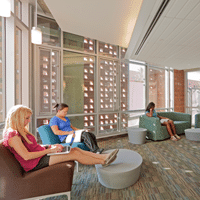With a student body totaling more than 30,000, the University of Arizona needed a way to provide new housing for students that served a triune purpose. The residences must reduce energy costs, incorporate organic visual design, and model sustainable practices for resident life. Recently opened for the 2011–2012 school year and built to mimic canyon and arroyo topography, UA’s new Sixth Street Residence Halls (SSRH) house 1,088 freshman students and are the first LEED Platinum residential units in Arizona. Debra Johnson, UA’s senior architect, gave us a tour.
Limited Boundaries
The primary challenge for the SSRH project—which comprises both the Árbol de la Vida and Likins halls—was getting the buildings to work with the surrounding area. “This is an urban campus, so we had limited planning boundaries,” Johnson says. Respondent to this, the architectural team at AR7 Architects was able to incorporate new space into the halls that works both practically and aesthetically. Johnson says, “We were able to build multiple courtyards into the design, and these become social spaces for the students that are private, secure, and enclosed by the buildings themselves.”
Modern Materials
Because the residence halls were being built within the campus precincts, Johnson says it was important for them to abide by the established architectural vocabulary. “We wanted … the halls [to] respect the campus context but still make them modern and unique,” Johnson says. The halls thus incorporate brick on the perimeter of the building to maintain this continuity, adding multicolored aluminum panels (No.1), stainless and galvanized metals, and stucco, provided by Mirage Plastering, on the interior, to bring lighter, reflective colors into the courtyards.
Organic Gatherings
Johnson says the angles in the buildings are intended to make the exterior spaces more organic, though this is reflected in the interiors as well. “We widened the hallways at the ends to provide spaces for students to gather,” Johnson says. “We also placed study rooms in the corridor centers to naturally allow people to transition from loud to quiet.” As with the exterior design, the goal was to integrate private and public areas (No.2). The areas were styled with furniture provided by Target Commercial Interiors, among others, and students were assured cohesive social space.
Operable Windows
Large windows in student rooms and study spaces allow for the influx of natural light, as does the buildings’ north-south orientation. Unlike many college dormitories, the windows in the SSRH are operable, which means they can be opened or closed relative to student preference (No.3). In addition to these passive strategies, all rooms are equipped with proprietary “smart” thermostats and occupancy sensors to conserve energy.
Double Solar
Heating domestic water uses a significant amount of energy in a residence hall. The desert conditions allow for practical implementation of rooftop solar-thermal systems to heat domestic water for the students. When it came to LEED scores, Johnson says the Energy and Atmosphere category was crucial. “We achieved 14 of 17 points here, and we were able to meet all energy-savings goals,” he says. The project was able to take advantage of off-site photovoltaic arrays, and the electrical design, provided by Monrad Engineering, has a lighting power density 45 percent more efficient than baseline and an electrical power density 10 percent more efficient than baseline.
Energy Education
Sixth Street residents benefit from the buildings’ spacious, landscaped courtyards, designed to mimic arroyo topography (No.4). They also can learn from their living quarters. The SSRH project received LEED points for education, as residence halls are integrated with a Web-based dashboard. This allows students to track and monitor energy usage and learn firsthand ways to moderate consumption and encourage green practices. “It was important that the residence halls’ utility information be accessible,” Johnson says, “because this allows us a direct way to instruct the students on the benefits of sustainability.”



